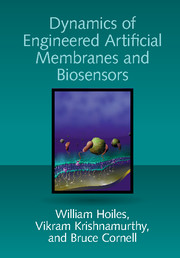Book contents
- Frontmatter
- Contents
- Preface
- List of Abbreviations
- Part I Introduction and Background
- Part II Building Engineered Membranes, Devices, and Experimental Results
- Part III Dynamic Models for Artificial Membranes: From Atoms to Device
- 8 Reaction-Rate-Constrained Models for Engineered Membranes
- 9 Reaction-Rate-Constrained Models for the ICS Biosensor
- 10 Diffusion-Constrained Continuum Models of Engineered Membranes
- 11 Electroporation Models in Engineered Artificial Membranes
- 12 Electroporation Measurements in Engineered Membranes
- 13 Electrophysiological Response of Ion Channels and Cells
- 14 Coarse-Grained Molecular Dynamics
- 15 All-Atom Molecular Dynamics Simulation Models
- 16 Closing Summary for Part III: From Atoms to Device
- Appendices
- Bibliography
- Index
8 - Reaction-Rate-Constrained Models for Engineered Membranes
from Part III - Dynamic Models for Artificial Membranes: From Atoms to Device
Published online by Cambridge University Press: 25 May 2018
- Frontmatter
- Contents
- Preface
- List of Abbreviations
- Part I Introduction and Background
- Part II Building Engineered Membranes, Devices, and Experimental Results
- Part III Dynamic Models for Artificial Membranes: From Atoms to Device
- 8 Reaction-Rate-Constrained Models for Engineered Membranes
- 9 Reaction-Rate-Constrained Models for the ICS Biosensor
- 10 Diffusion-Constrained Continuum Models of Engineered Membranes
- 11 Electroporation Models in Engineered Artificial Membranes
- 12 Electroporation Measurements in Engineered Membranes
- 13 Electrophysiological Response of Ion Channels and Cells
- 14 Coarse-Grained Molecular Dynamics
- 15 All-Atom Molecular Dynamics Simulation Models
- 16 Closing Summary for Part III: From Atoms to Device
- Appendices
- Bibliography
- Index
Summary
Introduction
Part II gave a detailed description of fabricating synthetic biological devices using engineered membranes and also discussed methods to perform experimental measurements. Constructing mathematical models that accurately predict the behavior of engineered membranes is important, both for the design of devices built out of the membrane and for estimating parameters such as analyte concentration and membrane conductance. This chapter focuses on constructing reaction-rate models for engineered membranes. Such models comprise a system of nonlinear ordinary differential equations and can be viewed as a black-box phenomenological model for the underlying synthetic biological device. Reaction-rate models account for the dynamics of tethered membranes that are excited by voltages less than 50 mV; therefore, the process of electroporation is not present. Specifically these models in combination with experimental measurements can be used to estimate the structural integrity of the tethered membrane and the disulfide bonds that anchor the tethers to the gold bioelectronic interface.
When an electrical potential is established across a tethered membrane, the macroscopic reaction-rate model for the current flowing through the membrane is equivalent to a lumped electrical circuit composed of resistors and capacitors as shown in Figure 8.1. In other words, the simple resistor–capacitor (RC) circuit of Figure 8.1 models the electrical response of the engineered membrane at a macroscopic level. The resulting current voltage response is a second-order linear system of ordinary differential equations. Though widely used to study the dynamics of tethered membranes, this reaction-rate model cannot account for the restricted diffusion dynamics that occur at the electrode surface. Modeling these effects requires introducing fractional-order operators. The fractional-order macroscopic model of the tethered membrane accounts for both the charging dynamics of the membrane and the restricted diffusion dynamics at the electrode surface. This chapter also presents a fractional-order macroscopic model for tethered membranes that contain sterol molecules (e.g., cholesterol). All the reaction-rate models in this chapter are validated using real-world experimental data from engineered membranes with different tether densities, lipid compositions, and analyte solutions.
Remark: Digital data acquisition, i.e., how the measured current is time sampled and digitized for processing on a computer, is not described in this book. Excellent resources for the design of analog-to-digital converters, time discretization, and antialiasing filters are [52, 102].
- Type
- Chapter
- Information
- Dynamics of Engineered Artificial Membranes and Biosensors , pp. 139 - 158Publisher: Cambridge University PressPrint publication year: 2018



